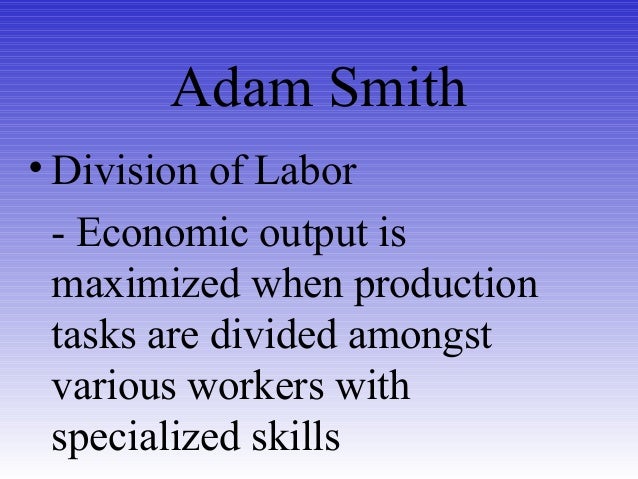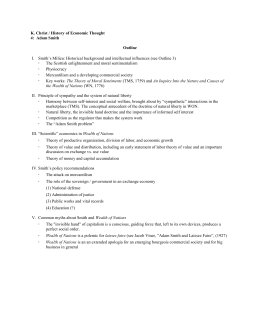Recent Posts
· The division of labor is the central factor in Smith’s theory of economic growth. Division of labor is the splitting of a large task into smaller tasks and then having one person is responsible for only one or two of the smaller tasks, which leads to an increase in productivity and stimulates the entire growth cycle, which increases the efficiency of the whole task While division of labor is crucial to the economic growth of a society. Smith insists that such process was not the effect of any human foresight or knowledge. Instead, he asserts that it is developed out of necessity and the human’s natural propensity to truck, barter, and exchange one thing for the other” (Smith 13) Summary. The division of labor (DOL) is not originally the effect of any human wisdom, but a very slow and gradual consequence of human propensity to truck, barter, and exchange one thing for another. According to Adam Smith, it is common and necessary to

CHECK THESE SAMPLES OF Adam Smith/Division of Labour
The absolute cost of Adam Smith is based on the division of labor theory. Adam introduced the division of labor theory to the field of international trade and established his absolute cost theory, thus demonstrating the fact that a nation can make the sources of each country most efficiently used to gain the increase of the total production, the enhance of consumption level First, Smith attests that the division of labour increases dexterity within the workplace. By dexterity, Smith means that an individual performing one task repetitively can accomplish that task faster than an individual who attempts to accomplish all tasks by himself. Carpentry is a prime example of Smith’s division of labour Adam Smith was one of the first economists to bring forward the idea of division of labor and specialization. This was first presented in his book “The Wealth of Nations” in This study will critically analyze the chapter “of the Division of Labor” which was included in the classics of organizational theory by Shafritz, Ott and Jang

Cite this page
Summary. The division of labor (DOL) is not originally the effect of any human wisdom, but a very slow and gradual consequence of human propensity to truck, barter, and exchange one thing for another. According to Adam Smith, it is common and necessary to “Adam Smith is one of the first political economists to deal at length with the organization of economic production in human society as an object of social analysis. Explain why he thinks that the division of labor is a key concept in producing complex economies, and how trade acted as a key element in transforming social organization.” The absolute cost of Adam Smith is based on the division of labor theory. Adam introduced the division of labor theory to the field of international trade and established his absolute cost theory, thus demonstrating the fact that a nation can make the sources of each country most efficiently used to gain the increase of the total production, the enhance of consumption level

Extract of sample "Adam Smith/Division of Labour"
· The division of labor is the central factor in Smith’s theory of economic growth. Division of labor is the splitting of a large task into smaller tasks and then having one person is responsible for only one or two of the smaller tasks, which leads to an increase in productivity and stimulates the entire growth cycle, which increases the efficiency of the whole task First, Smith attests that the division of labour increases dexterity within the workplace. By dexterity, Smith means that an individual performing one task repetitively can accomplish that task faster than an individual who attempts to accomplish all tasks by himself. Carpentry is a prime example of Smith’s division of labour While division of labor is crucial to the economic growth of a society. Smith insists that such process was not the effect of any human foresight or knowledge. Instead, he asserts that it is developed out of necessity and the human’s natural propensity to truck, barter, and exchange one thing for the other” (Smith 13)

Categories
First, Smith attests that the division of labour increases dexterity within the workplace. By dexterity, Smith means that an individual performing one task repetitively can accomplish that task faster than an individual who attempts to accomplish all tasks by himself. Carpentry is a prime example of Smith’s division of labour Intro In this chapter, Adam Smith argued about the concept of division of labor because you have to use resource in the right way that you can get the highest productivity. Division of labor in manufacture is the way that the firm subdivided labor into the steps, different labor divide in different step like the example about pin factory in the book First of all, it should be noticed that Adam Smith was completely right when he claimed that the division of labor leads to significant improvement of labor productivity. Considering the evidence provided by the author and the character of the economic development of the global economy, it can be stated that the division of labor increases productivity
No comments:
Post a Comment